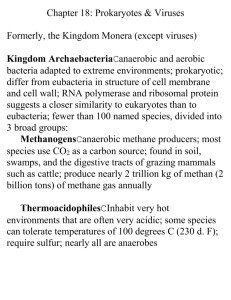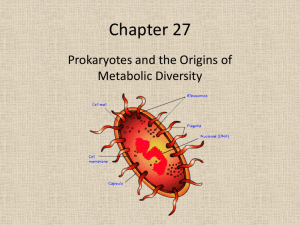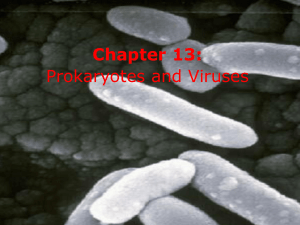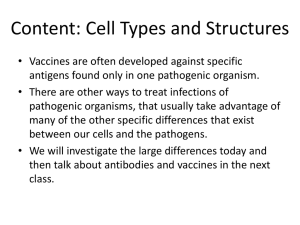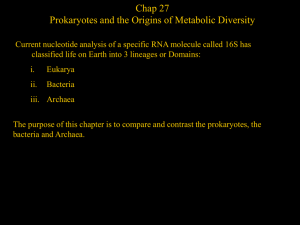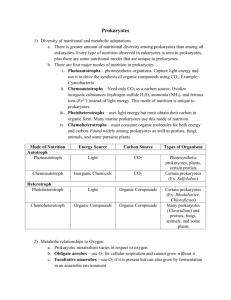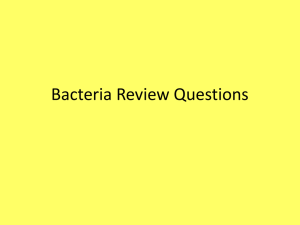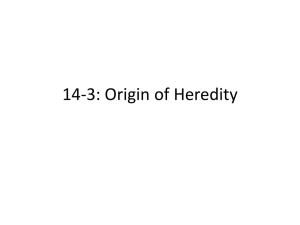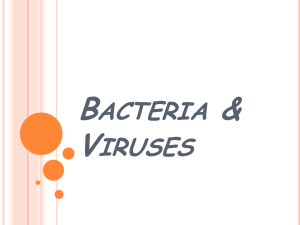Prokaryotes and the Origins of Metabolic Diversity
advertisement
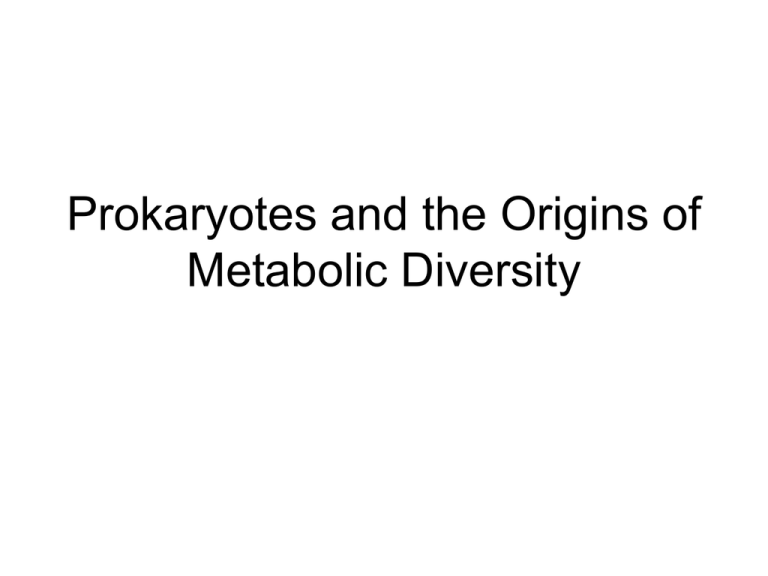
Prokaryotes and the Origins of Metabolic Diversity Unique Characteristics and Success on Earth • Found everywhere … ubiquitous! • Unicellular • One chromosome which is circular • Lack membrane enclosed organelles • Asexual … binary fission • Smaller ribosomes • Small (1-5µm) • Huge diversity • Most ancient life • Live in extreme environments Impact on Biological Ecosystems • Decompose dead matter • Cycle Carbon, Nitrogen from organic material to soil and atmosphere. • Lakes, rivers, oceans … return chemical elements as inorganic compounds that can be used by plants. • Symbiotic relationships – Intestines – Vitamins – Mouth – kill fungi – Mitochondria and chloroplasts evolve from prokaryotes that are residents in host cells 3 Domain System • 2 major groups of prokaryotes • Archaea – “ancient” – Extreme habitats – Share some similarities with Eukaryotes • Bacteria – Common prokaryotes we encounter Size, Organization, Specialization • • • • Mostly unicellular Cocci, Bacilli, Helical 1-5 µm Some prokaryotes will specialize and create a division of labor – Nitrogen fixation – Anti-fungal Structure, Composition, and Function of Cell Walls • Maintains Shape • Physical Protection • Prevents Bursting in Hypotonic Solution • Peptidogylcan – sugars cross-linked by polypeptides (not in Archaea) • Gram+ = simpler wall w/ lots of peptidoglycan • Gram- = more complex w/ lipopolysaccharids but w/ less peptidoglycan Gram Stain and Disease • Gram+ – Peptidoglycan traps the crystal violet – Stains blue/purple • Gram– Less peptidoclycan, crystal violet easily rinsed away but safranin dye is retained – Stains pink – Lipopolysaccharides are often toxic – Outer membrane helps defend against host and antibiotics (prevent cross link in peptidoglycan) Motility and Flagella • • ½ of prokaryotes are capable of movement (some 100 X body / second) Flagella – Smaller than eukaryotes, not covered by membrane – Filaments rotate and cell is propelled – Powered by diffusion of H+ ions • Spirochetes – Helical filaments; corkscrew movement • Gliding (Slime) – Filamentous chains secrete slime for gliding • Chemotaxis – Postive or negative • Phototaxis Prokaryotic Genome • No “true” nuclei • Small, simple genome • 1/1000th as much DNA as a eukaryote • Nucleoid Region – Double stranded DNA in from of a ring – Plasmids – Smaller rings of DNA • Smaller ribosomes – Tetracyline and chloramphenicol bind to ribosomes and block protein synthesis Genetic Variation • Transformation – Genes taken in from surrounding environment • Conjugation – Genes exchanged between bacteria (direct) • Transduction – Genes transferred via a virus • Mutation – Random change in DNA sequence due to replication error – Most common source of variation Bacterial Growth • Multiplication of cells and increase in population size • NOT enlargement of individual cells • Conditions for optimal growth will vary – Temp, pH, salts, nutrients • Refrigeration – Slows the growth of microorganisms • Geometric Growth – 20 minutes – 3 hours – Colony outweigh Earth in 3 days Endospores • Resistant Cells • Replication of chromosome which is surrounded by a durable wall • Allows for protection in harsh conditions • May lie dormant for centuries (250 my) • Food-canning industry must take precautions Antibiotics • Inhibit the growth of microorganisms • Prokaryotes must compete for space and nutrients • Defense against other bacteria or protists and fungi Zone of Inhibition Obtaining Energy and Carbon Mode of Nutrition Photoautotroph Chemoautotroph Energy Source Light Carbon Source CO2 Inorganic CO2 chemicals PhotoLight heterotroph ChemoOrganic heterotroph compounds Organic compounds Organic compounds Types of Organisms Cyanobacteria, plants Prokaryotes Sulfolobus Prokaryotes Prokaryotes Protists, fungi, animals Diversity among Chemohetertrophs • Saprobes – Decomposer that absorb their nutrients from dead organic matter • Parasites – Absorb nutrients from the body fluids of living hosts • Almost any organic molecule can serve as food for at least some species. (petroleum) • Nonbiodegradable – Cannot be broken down by chemoheterotrophs Nitrogen Fixation • Nitrogen is an essential part of proteins and nucleic acids • Prokaryotes are able to metabolize most nitrogenous compounds • Convert ammonium (NH4+) to Nitrite (NO2-) • “Denitrify” = Nitrate (NO3-) to N2 (gas) • Nitrogen fixation – N2 (gas) to ammonium (NH4+) – Only biological mechanism that converts atmospheric nitrogen available to incorporate into organic material Metabolic Relationships to Oxygen • Obligate aerobes – Use oxygen for cellular respiration and cannot grow without it • Facultative anaerobes – Uses oxygen if present but can also grow by fermentation (anaerobic) • Obligate anaerobes – Poisoned by oxygen – Fermentation – Anaerobic respiration (inorganic molecules accept electrons at the “downhill” end of ETC) Evolution of Metabolic Diversity • Glycolysis – Heterotrophic bacteria use the organic material in the “primordial soup” – Depleted supply of organic material • Bacteria that can harness the energy from sunlight and carbon dioxide are favored • Electron Transport Chains Develop • Photosynthesis • Cellular Respiration Moneran Classification • Molecular Systematics – Signature sequences of small-subunit ribosomal RNA (SSU-rRNA) – Create history of earliest prokaryotes to modern life • Clinical Phenotypes – Useful for identification – Poor for phylogeny – Nutritional modes are scattered around the phylogenetic tree Extremophiles • Methanogens – – – – Use carbon dioxide to oxidize hydrogen Produces methane (CH4) Anaerboes Found in swamps, marshes, sewers, guts of animals • Extreme halophiles – “salt lovers” – Found in the Great Salt Lake and Dead Sea • Extreme thermophiles – Thrive in hot environments – Optimal temperature is usually 60-80oC Recycling • Atoms of the organic materials in our bodies were once part of the inorganic compounds in the soil, air, and water. • Bacteria act as decomposers. – Return carbon, nitrogen, etc. from organic material and waste products. Relationships • Symbiosis – “living together” • Mutualism – Both organisms benefit – Ex: bacteria in root nodules of beans (fix nitrogen) • Commensalism – One organisms benefits, while the other is not harmed or helped – Ex: bacteria on the outer surfaces of the body • Parasitism – One organism benefits (parasite) at the expense of the other – Ex: pathogens – cause disease in the host Koch’s Postulates • The organism must be found in all animals suffering from the disease, but not in healthy animals • The organism must be isolated from a diseased animal and grown in pure culture. • The cultured organism should cause disease when introduced into a healthy animal. • The organism must be reisolated from the experimentally infected animal. Exotoxins vs. Endtoxins • Exotoxins – Proteins secreted by prokaryotes – Can produce disease even w/o bacteria – Ex: Clostridium botulinum – 1 gram of botulism can kill 1 million people – Ex: Vibrio cholerae – causes cholera, which is characterized by severe diarrhea • Endotoxins – Components of outer membranes of Gram- bacteria – Ex: Salmonella typhi – causes typhoid fever Streptomyces • Soil bacteria responsible for many antibiotics including – Streptomycin, neomycin, erythromycin, aureomycin and tetracyclin • Used to produce recombinant human proteins • Derived the anti-fungal drug nystatin Limitations of Antibiotics • Rapid evolution of antibiotic-resistant strains of pathogenic bacteria. • Biological Weapons – Vlad III the Impaler – Native Americans decimated with Old World diseases – Diseases considered for weaponization, or known to be weaponized include anthrax, Ebola, Bubonic Plague, Cholera, Tularemia, Brucellosis, Q fever, Machupo, Coccidioides mycosis, Glanders, Melioidosis, Shigella, Rocky Mountain Spotted Fever, Typhus, Psittacosis, Yellow Fever, Japanese B Encephalitis, Rift Valley Fever, and Smallpox. Naturally-occurring toxins that can be used as weapons include Ricin, SEB, Botulism toxin, Saxitoxin, and many Mycotoxins. The organisms causing these diseases are known as select agents. Their possession, use, and transfer are regulated by the Centers for Disease Control and Prevention's Select Agent Program. Exploitation of Prokaryotes
